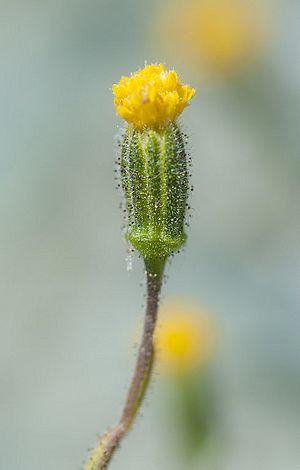Rayless tidytips facts for kids
Quick facts for kids Layia discoidea |
|
|---|---|
 |
|
| Scientific classification | |
| Kingdom: | |
| (unranked): | |
| (unranked): | |
| (unranked): | |
| Order: | |
| Family: | |
| Genus: |
Layia
|
| Species: |
L. discoidea
|
| Binomial name | |
| Layia discoidea Keck
|
|
Meet the Layia discoidea, a special and rare flower! It's part of the daisy family, just like the daisies you might see in your garden. People often call it the rayless tidytips or rayless layia.
Contents
Where This Special Plant Lives
This unique plant only grows in a few specific places in California. It loves a special type of soil called serpentine soil. You can find it mainly in the Diablo Range mountains, in southern San Benito County and western Fresno County.
It lives in areas like the New Idria serpentine area, and other spots like Laguna Mountain and Panther Peak. This plant really prefers rocky, sunny places. It grows well where other plants don't, so it doesn't have to compete for space or sunlight.
What Does Layia discoidea Look Like?
This plant is an annual herb. This means it grows from a seed, flowers, makes new seeds, and then dies all in one year. It has a small stem that can grow up to about 20 centimeters tall, which is about the length of a ruler. The stem is a bit sticky.
Its leaves are usually long and thin, shaped like a spear. The leaves closer to the bottom of the plant might have small lobes or bumps.
Flowers Without Rays
Most daisies have colorful "petals" around the edge, which are called ray florets. Think of a sunflower's yellow "petals." But Layia discoidea is special because it doesn't have these ray florets! That's why it's called "rayless."
Instead, its flower head is a tight bunch of many deep yellow disc florets. These are the small, tube-shaped flowers you see in the center of a daisy. The base of the flower head has small, leaf-like scales. After the flower blooms, it produces a small fruit called an achene. This fruit has a short, scaly, brown top, which helps it spread its seeds.
How Layia discoidea Evolved
Scientists have studied the genes of Layia discoidea. They think it evolved directly from another plant called Layia glandulosa. This is an example of how new species can form over time.
Even though Layia discoidea looks very different from Layia glandulosa (which usually has white ray florets), their genes are quite similar. They can even create healthy baby plants if they are crossed!
Sometimes, you might see a Layia discoidea plant with light yellow ray florets. Scientists are still trying to figure out why this happens. It could be because of mixing with Layia glandulosa, a natural change in its genes, or even just how the plant reacts to its environment.

